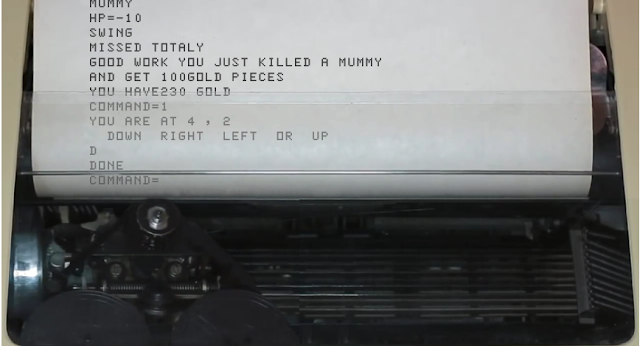From CRPG Adventures
Normally, my final post for a game would be titled with some variation of Victory, possibly modified with punctuation to indicate how emphatic said victory was. DND1 has no victory state though, and to be honest I’ve rather more abandoned playing it than finished it. The last month has been a hectic, life-changing one to say the least, and my limited gaming time has been given over to games rather more accessible and enjoyable than this one. (Sorry, Mr. Garriott.)
I had said in the last post that I was going to explore the equipment options and spells that I had yet to get to. I tried, but none of them seemed to work. I had thought that the cross might damage undead, or that I might be able to attack with oil flasks, but for whatever reason those options didn’t work. I may have been doing it wrong, or it could just be that those functions weren’t implemented yet. Likewise, I had no success in getting spells to work. Of the cleric spells, I only had success with those for detecting traps and secret doors. For magic-users, I had no success at all. Again, I’m not sure where the fault lies there.
So, in the interests of moving on from what should really have been a one post game, I’m going to wrap things up and give DND1 a Final Rating. Before I get into it, it should be noted that this game was never intended for public consumption. It wasn’t a commercial release, and it wasn’t played by students on a mainframe. Perhaps it isn’t fair to rank it against such games, but in the interests of being comprehensive I’m still going to do so.
Story and Setting: The game has neither, which is pretty much a given when you take its origins into account. The dungeon is a generic collection of rooms and corridors, and the only story is the protagonists purposeless quest for gold and power. Calling it basic would be an overstatement. Rating: 1 out of 7.
Characters & Monsters: There are no characters, but a decent selection of D&D monsters: orcs, skeletons, trolls, balrogs, etc. The monsters have very little to differentiate them, however, so I can’t rate it highly. Rating: 1 out of 7.
Aesthetics: The problem here is that, this being a browser-based recreation of DND1 rather than the game itself, we have no way of knowing what the original actually looked like. One of the versions I played featured ASCII art with a top-down display, and the other featured a graphical interface that emulated a teletype machine. The second one was probably more accurate to the original, and what little I played of it was a bit of a nightmare, as the map wasn’t permanently shown. Either way, the game has little visual appeal. Rating: 1 out of 7.
 |
| What the game might have looked like on a teletype. |
Mechanics: There’s a lot to like here, and a lot that seemed like it should have worked but didn’t. It has the basics of D&D all there: classes, ability scores, monsters, spells, and a good selection of gear. It begins a decent little dungeon-crawler, with some neat touches like the ability to lead monsters into traps. After a while, though, the monsters start dying instantly for no reason, and my inability to get the spells to work hurt it as well. Rating: 2 out of 7.
Challenge: It’s often hard to rate a game in this category when it doesn’t have a goal as such. For DND1 I suppose that goal is to become strong enough to survive in the dungeon, and that’s not at all difficult. The game is quite easy, and made easier by whatever it is that starts mysteriously killing monsters. Rating: 2 out of 7.
Innovation and Influence: This is where this game is going to shine. In terms of innovation, it’s interesting in that it stands apart from the two main lineages of 70s CRPGs (the top-down line started by pedit5 and DND, and the first-person line of Moria and Oubliette). It bears the most resemblance to the pedit5/DND lineage, but it’s quite obvious that it was originated by someone who hadn’t played them, and was just trying to recreate Dungeons & Dragons. Pretty much everything it does has been done elsewhere in 1970s RPGs (except using traps against monsters), but it does them all in its own way. As for influence, being the first game by Richard Garriott nets it a high score automatically. Though virtually nobody else ever saw it at the time, it was the beginning of a line that eventually spawned Akalabeth and Ultima, and that’s a huge deal. Rating: 7 out of 7.
Fun: I had a small amount of fun with this game; it’s a good one to play when you have a quick ten minutes to kill, as a dungeon delve rarely lasts all that long. In the end, though, there’s not a lot to it, and I ran out of things to discover about it fairly quickly. It’s more of a historical curiosity than an enjoyable game to play. Rating: 2 out of 7.
DND1 doesn’t get the bonus point, as I don’t think I’ll ever play it again. The above scores total 16, which doubled gives a Final Rating of 32. That places it equal 7th on the CRPG list, with Dungeon Campaign and Space. The only game lower is The Game of Dungeons v8.0, which is a better game but one I grew to hate a great deal over the year that I played it.
Next: I suppose I’ll restart MUD1, and actually post about it this time, unless some other lost classic from the 70s pops out of the woodwork.
Original URL: http://crpgadventures.blogspot.com/2018/05/dnd1-played.html
